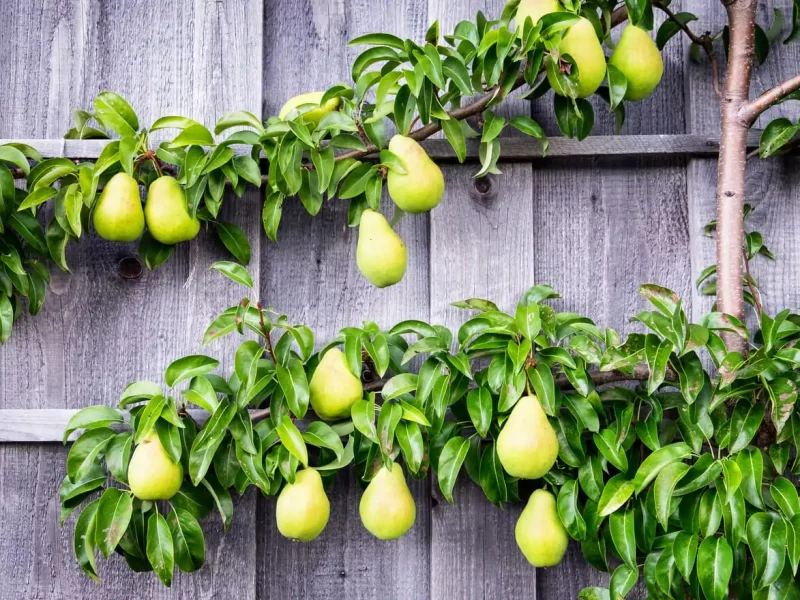
From Tradition to Trend: The Revival of Espalier Fruit Trees
In recent years, the British gardening scene has witnessed a remarkable resurgence of interest in espalier fruit trees. These meticulously trained and elegantly structured trees, once confined to the pages of history and the sprawling estates of yesteryears, are experiencing a renaissance in gardens across the country. From quaint suburban backyards to trendy urban allotments, espalier fruit trees are gracing our landscapes once more, combining timeless charm with contemporary flair.
In this article, we’ll explore the journey of espalier fruit trees from their storied past to their current status as a burgeoning gardening trend. We’ll delve into the benefits of growing espaliered fruit trees, the artistic appeal they bring to gardens, and practical tips for nurturing these living works of art. So, whether you’re a seasoned gardener looking to diversify your orchard or a newcomer eager to explore the world of horticulture, join us as we uncover the secrets and delights of espalier fruit trees.
The Artistry of Espalier: A Historical Perspective
Chrisbowers experts say that espalier fruit trees have a history steeped in tradition, dating back to ancient civilizations. The art of espaliering began with the Romans, who recognized the advantages of training fruit trees to maximize space, sunlight, and fruit production. Over time, this knowledge was passed down and refined by various cultures, particularly in medieval Europe.
The Byzantines: The Byzantine Empire made significant contributions to the development of espalier techniques. They adopted and adapted the Roman practice, using it not only for practical purposes but also as an ornamental feature in their palace gardens. Espaliered fruit trees adorned the courtyards, adding an element of sophistication to their surroundings.
Medieval Europe: Espalier fruit trees gained widespread popularity during the Middle Ages in Europe, particularly in France and Italy. Monasteries, known for their extensive gardens, were at the forefront of espalier cultivation. These religious institutions recognized the efficiency of growing fruit in limited space, while also appreciating the aesthetic value of neatly trained trees. Espaliered apple and pear trees thrived within the protective walls of monastic gardens, providing both sustenance and visual appeal.
Renaissance Gardens: The Renaissance period witnessed a flourishing interest in art, science, and horticulture. Italian and French Renaissance gardens showcased the beauty of espaliered fruit trees, often arranging them in intricate patterns and designs, such as the popular “cordon” style. European nobility followed suit, incorporating espaliered fruit trees into their grand estate gardens as symbols of prestige and refinement.
The Decline and Revival of Espalier
As the centuries rolled on, the popularity of espalier fruit trees waned. Changing gardening trends and the advent of modern horticultural practices led to a decline in this ancient art. Espaliered trees gradually became overshadowed by the allure of larger, freestanding fruit orchards.
Industrialization and Urbanization: The Industrial Revolution brought about significant changes in agriculture and society. With the rise of industrial farming, traditional gardening techniques like espalier became less common. Urbanization further reduced available garden space, discouraging the practice of training fruit trees along walls.
Modern Orchard Practices: Commercial fruit production shifted towards more intensive, high-yield methods that prioritized quantity over aesthetics. The modern consumer market also favored standardized, unblemished fruit, which didn’t align with the quirks of espaliered trees.
However, in recent years, there has been a remarkable resurgence of interest in espalier fruit trees. Gardeners across the UK are rediscovering the charm and utility of these trained trees, and here are some compelling reasons behind this revival.
Benefits of Growing Espalier Fruit Trees
Space Efficiency
One of the most significant advantages of espalier fruit trees is their space-efficient nature. In an era where gardens are shrinking due to urbanization, having a compact yet productive orchard is a valuable asset. Espaliered trees can be trained to grow flat against walls or fences, making them ideal for small gardens, courtyards, or even balconies.
Increased Sunlight Exposure
Espaliering allows you to maximize sunlight exposure for your fruit trees. By carefully arranging branches, you can ensure that each part of the tree receives adequate sunlight, promoting healthier growth and better fruit production. This is particularly advantageous in the UK, where sunlight can be limited, especially during the winter months.
Artistic Garden Features
Espalier fruit trees are not just practical; they are also living works of art. Their intricate, tiered structures and beautifully pruned branches add an element of elegance and sophistication to any garden. Whether you opt for classic fan shapes or experiment with more modern designs, espaliered trees become focal points and conversation starters in your outdoor space.
Pest and Disease Management
Due to their compact growth and well-maintained structure, espalier fruit trees are easier to inspect and manage for pests and diseases. Early detection and intervention can prevent infestations from spreading to the entire tree, allowing you to maintain healthy, disease-resistant plants.
High-Quality Fruit
While espaliered trees may produce slightly less fruit per tree compared to their untrained counterparts, the quality of the fruit is often superior. The controlled growth and pruning of branches result in larger, juicier, and better-ripened fruit. Homegrown apples and pears from espaliered trees are renowned for their exceptional taste.
The Aesthetic Appeal of Espalier
Espalier fruit trees are not merely functional; they are a testament to the marriage of horticulture and artistry. When carefully trained, these trees can take on a variety of shapes and patterns, offering endless possibilities for garden design. Here are some popular espalier forms that can elevate your garden’s aesthetic:
Fan Espalier
The fan espalier is one of the most classic and visually striking forms of espalier. The branches radiate out from a central vertical trunk, resembling the shape of a hand-held fan. This design not only allows for maximum sunlight exposure but also creates a captivating focal point in your garden.
Cordon Espalier
Cordon espalier is characterized by a single, central vertical stem with short horizontal branches extending on either side, resembling the rungs of a ladder. This style is both space-efficient and visually appealing, making it a popular choice for modern gardeners.
Belgian Fence
The Belgian fence, also known as the crisscross or lattice espalier, features multiple horizontal branches intertwined at diagonal angles to create a lattice-like pattern. This intricate design adds a touch of complexity and elegance to your garden, especially when planted against a wall or fence.
Palmette Espalier
The palmette espalier is inspired by the shape of a palm frond, with branches radiating outward in a semi-circular or “V” shape. This style exudes a sense of symmetry and balance, making it a perfect choice for formal gardens and avenues.
Cultivating Espalier Fruit Trees: Tips and Techniques
If you’re eager to embark on your espalier journey, here are some essential tips and techniques to ensure your success:
Select the Right Variety
Choose fruit tree varieties that are well-suited for espalier training. Apples and pears are classic choices, but other options like peaches and cherries can also be trained successfully.
Prepare the Support Structure
Before planting your tree, ensure you have a sturdy support structure in place. This could be a wall, fence, trellis, or wires stretched between posts. The support should be strong enough to bear the weight of the tree as it grows.
Prune with Precision
Pruning is the key to achieving the desired espalier shape. Start by pruning in the dormant season, removing excess branches and encouraging the growth of those you wish to retain. Regular pruning throughout the year will help maintain the shape and encourage fruit production.
Tie and Train
Use soft ties or horticultural tape to secure branches to the support structure. Train the branches in the desired pattern, whether it’s a fan, cordon, or any other style. Be gentle and patient, as it may take a few seasons to achieve the perfect form.
Water and Feed Adequately
Provide your espaliered tree with consistent water and nutrient supply. Proper hydration and nutrition are essential for healthy growth and fruit development.
Monitor for Pests and Diseases
Keep an eye on your tree for any signs of disease or pests. Early intervention is critical to prevent issues from spreading. When you can, try to eliminate pests naturally.
Espalier: A Return to Tradition with a Modern Twist
The revival of espalier fruit trees represents a delightful convergence of tradition and contemporary gardening trends. As we look to maximize our garden spaces, optimize sunlight exposure, and infuse artistic elegance into our landscapes, espaliering offers a solution that fulfills these desires.
With its rich historical roots and a renewed appreciation for its many benefits, espaliering has found a secure place in British gardens once more. Whether you’re cultivating a compact urban oasis or adorning the walls of your countryside estate, espalier fruit trees provide an opportunity to connect with horticultural history while creating a living masterpiece in your own backyard.
As you embark on your espalier journey, remember that patience and care are the keys to success. With each well-pruned branch and each succulent harvest, you’ll not only reap the rewards of your efforts but also contribute to the revival of a cherished horticultural tradition.
In conclusion, the revival of espalier fruit trees is not merely a trend but a celebration of the enduring appeal of age-old horticultural practices. As we continue to explore the boundaries of modern gardening, let us not forget the treasures of our gardening heritage. Espaliered trees serve as a bridge between the past and the present, offering a taste of history and a glimpse of a greener, more artful future for our gardens. So, why not embark on this timeless journey and bring the beauty of espalier to your own slice of British greenery?




